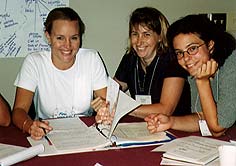|
Invited Symposia
European Immersion: Context, Content and Cognition
Organizer:
Siv Björklund, Professor, Centre for Immersion and Multilingualism, University of Vaasa, Finland
Co-presenters:
Mari Bergroth, Ph.D, Researcher, Centre for Immersion and Multilingualism
Karita Mård-Miettinen, Ph.D, Senior Assistant in Swedish immersion, Centre for Immersion and Multilingualism
Nina Niemelä, Doctoral candidate and researcher, Centre for Immersion and Multilingualism
Abstract
The development of immersion programs in Europe is closely linked to the language history and language needs of individual nations and regional areas. The aim of this symposium on European immersion is to start with an historical overview of the implementation of immersion programs in different parts of Europe. The discussion will then shift from more locally oriented, program-based initiatives to current global European perspectives on language education. Brief presentations of key features such as language competence and evaluation, immersion teaching and content-specific knowledge in a second language will be analyzed and used as starting points for discussion among symposium participants.
The European Immersion Context, A Comparative Analysis
Björklund & Mård-Miettinen
The main focus of this presentation will be on a comparative analysis of immersion programs in distinct parts of Europe. The different approaches to integrating language and content will be introduced. European immersion program comparisons will also include motives for establishment (enrichment, language revitalization and maintenance, cultural and social integration), the official (or unofficial) language policy of different regions, the design of programs, and process- and product-oriented evaluation and research.
The Common European Framework of Reference for Languages and Immersion Education
Mård-Miettinen
The Common European Framework of Reference for Languages: Learning, teaching, assessment published by the Council of Europe in 2001 recommends products and processes to be used when planning and setting up language teaching in a country or in a single school. Using Swedish immersion in Finland as a model, this presentation relates the Framework’s philosophy and the suggestions it makes on language learning, language teaching and language assessment to international immersion research and practices.
Language for Special Purposes, Second Language Development and Immersion
Björklund, Bergroth, Mård-Miettinen & Niemelä
While a content and language integrated approach is widely recognized as one of the key components of immersion, little research has been conducted on the relationship between second language (L2) development and language for special purposes (LSP) in immersion. The content and language integrated approach in immersion offers unique opportunities to follow cognitive development and ways of expressing cognitive growth in a L2. For research to progress in this direction we have to advance from an overt focus mainly targeting content-specific lexicon in the L2 towards ways of analyzing how individual content-domains construct knowledge and the linguistic preferences used to express these knowledge structures (LSP). This presentation shares results from an ongoing immersion project (Cognition and interaction) at the Centre for Immersion and Multilingualism.
Bilingualism, Biliteracy, Biculturalism: Recent Research on the Goals of Two-Way Immersion Organizer:
Donna Christian, Center for Applied Linguistics
Presenters:
Kathy Escamilla, Professor, School of Education, University of Colorado
Ester de Jong, Assistant Professor, College of Education, University of Florida
Kathryn Lindholm-Leary, Professor, Child and Adolescent Development, San José State University
Abstract
This symposium features three reports on recent investigations of the generally-accepted goals of two-way immersion education: bilingualism, biliteracy, and biculturalism for all students.
Examining the Writing of Emerging Biliterate Children
Kathy Escamilla
This study examines writing samples in English and Spanish of emerging biliterate students in grades 1-3 who are participating in a bilingual intervention study. The presentation will report on the correlation between Spanish/English writing outcomes, cross-language transfer, and the bilingual strategies that children employed in their writing in both English and Spanish.
Lessons from Longitudinal Studies of Bilingualism and Biliteracy in TWI Programs
Kathryn Lindholm-Leary
Students in TWI programs achieve at levels comparable or superior to their peers in English mainstream programs, but there is not much detail about the trajectory toward bilingualism and biliteracy for students with different profiles. This study examines longitudinal language proficiency and achievement data for students in grades 3-7 in 50/50 and 90/10 TWI programs.
Is There a Match? Anglo and Latino Adolescents’ Views of their Two-Way Program
Ester de Jong
This study reports on the experiences of TWI students in grades 6-12 and their perceptions of how the program changes from elementary to middle to high school. Using survey and focus group data, the paper discusses perceptions of bilingualism and biculturalism, views of the role of Spanish and how these views compare with the program’s stated goals, and observations about effective classroom practices.
|




